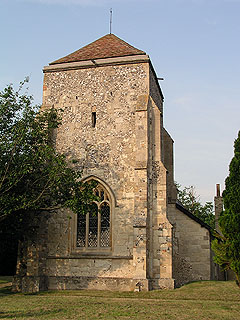As I remarked in the entry for Meldreth, these train-station villages on the south-western approach to Cambridge evoke mixed memories for me. There, the church confounded my prejudice. Here, I'm afraid, All Saints rather compounded it. I'm rather confused about this church. To us, it looked like it was entirely rebuilt in the 18th century at the earliest, save for the tower and a few details like the north doorway. The nave is built in that particularly horrid yellow-white brick you get in this area, and although it hasn't turned acid green with lichen in the way that it normally does, it's still very ugly. We couldn't get in, and there were no keyholders listed, but we didn't think that this was much of a loss. I resolved to note the rather nice transitional north doorway and the endearingly solid, ancient-looking tower, and to leave it at that.
Pevsner, though, mentions a Norman chancel arch - indeed, I've seen it mentioned as late Saxon elsewhere, and mentions 13th century windows in the nave (though he does concede that the wall in which they were set seemed to be new). There doesn't seem to be any definitive statement on the matter (alas, the RCHM doesn't cover this bit of the world). Is this a pioneering building of the 13th century by some visionary mason who desired his church to look like a 20th century electricity substation? Is the nave a rebuilding of the 18th century, as the chancel apparently is? Or is it a 20th century monstrosity, as it seemed to my eyes? Norman chancel arch notwithstanding, I can't really be bothered to expend much effort in finding out, but if someone does know then please drop me a line.
All Saints was locked, with no keyholders listed.
